The Trophy was the Journey
CELEBRATE NATIONAL BISON DAY Sat, Nov, 6, 2021!!
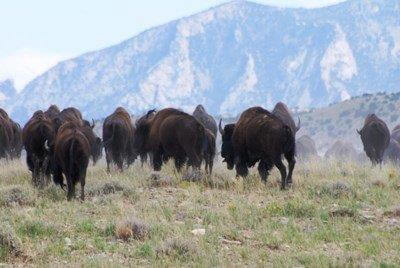
Bison in the Henry Mountains, Utah, where a target 500 buffalo and cattle run together on the same BLM range. Photo credit Bill Bates, Wildlife Section Chief for the Utah Division of Wildlife Resources.
“They have a huge hump, giant head, eyeball the size of a billiard ball. What is not to like?” – Padgett Powell
My once in a lifetime hunt ended on a beautiful Saturday morning in early November 2017, but it began many years earlier.
The animal would be the first and last bison I will ever kill. Something that only a handful of hunters get the chance to do in the twenty-first century.
The trophy was indeed the journey it took to reach this milestone.
My quest to understand and learn about the bison has carried me across thousands of miles: from the badlands of North Dakota, to Montana’s National Bison Range, from Yellowstone National Park, to Utah’s Antelope Island State Park.
For decades I’ve studied and observed this country’s national mammal, and I have grown to love it, which you can’t do until you actually get to know the animal. Because of this journey, my interest in the bison will be a lifelong love affair.
How can I claim to love the very thing that I worked so hard to kill? I’ve thought of this often lately.
John Mason said it best, “I do not hunt for the joy of killing but for the joy of living, and for the inexpressible pleasure of mingling my life, however briefly, with that of a wild creature that I respect, admire, and value.”
At the apex of their reign the American buffalo (Bison bison) roamed over much of North America in countless numbers.
However by 1890, less than a thousand animals could be found on the entire continent! Today there are scattered herds in private and public ownership.
Utah has three of these herds, one on Antelope Island, one in the Book Cliffs /Indian Reservation, and one on the Henry Mountains.

John Mason said it best, “I do not hunt for the joy of killing but for the joy of living, and for the inexpressible pleasure of mingling my life, however briefly, with that of a wild creature that I respect, admire and value.” Buffalo in the Henry Mountain Range, photo credit Russell Nielson.
****
For the entirety of man’s existence in North America, we’ve struggled with the meaning of this animal, with the ways in which its life is intertwined with our own…I sometimes imagine that we saved the buffalo from the brink of extinction for the simple reason that the animal provided a handy mirror in which we could see our innermost desires and failures, and our most confounding contradictions. Our efforts to use the buffalo as a looking glass have rendered the animal almost inscrutable. At once it is a symbol of the tenacity of wilderness and the destruction of wilderness; it’s a symbol of Native American culture and the death of Native American culture; it’s a symbol of the strength and vitality of America and the pettiness and greed of America; it represents a frontier both forgotten and remembered; it stands for freedom and captivity, extinction and salvation. Perhaps the buffalo’s enduring strength and legacy come from this chameleonic wizardry, this ability to provide whatever we need at the given moment. –Steven Rinella, American Buffalo
Bison in Utah’s Henry Mountains are among the few herds in North America that are genetically pure. This is because in 1941, fifteen cows and three bulls were captured in Yellowstone and released by the Utah Division of Wildlife Resources into the San Rafael Desert in Southeastern Utah.
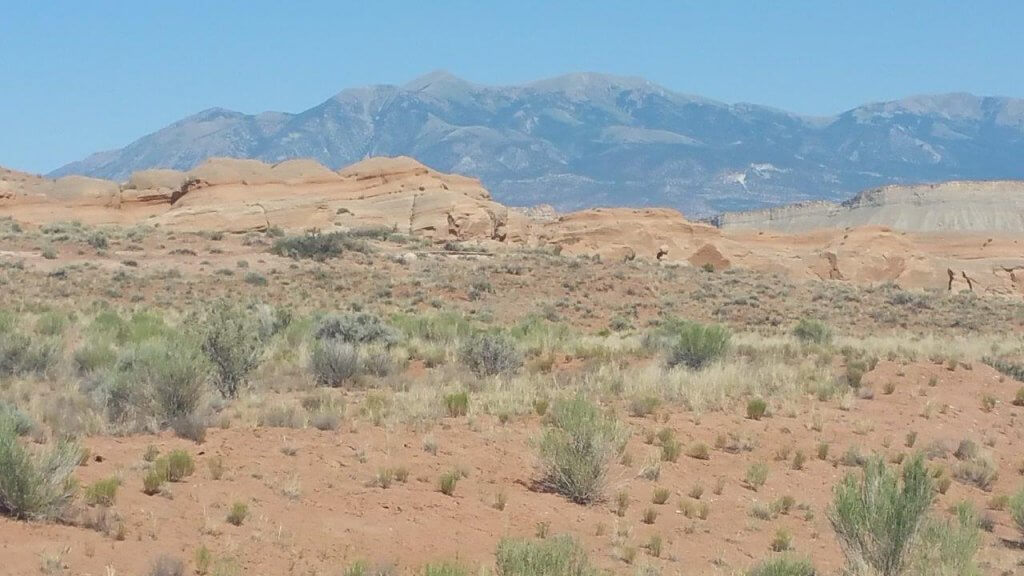
The Henry Mountains—in background—rise directly out of the barren, but scenic deserts of Southeast Utah. Credit RN.
The herd eventually migrated to the Henry Mountains. This herd is the only free-roaming herd in the lower 48 states that is managed by hunting alone and has 1600 square miles in which to roam. The sustained target population is 500 animals.
The Henry Mountains rise directly out of the barren, but scenic deserts of Southeast Utah. A certain mystique has always surrounded the mountains and they are steeped in history.
These mountains are located northwest of Lake Powell and east of Capitol Reef National Park. They are about 60 miles long by 20 miles wide. Before being named the Henry Mountain, they were known as the “Unknown Mountains” and for good reason.
The Henry Mountains were the last range in the United States to be “discovered” (1860) and didn’t appear on any maps until 1872.
They were one of the last-surveyed and last-named mountain ranges in the lower forty-eight states. They were named by Almon Thompson (John Wesley Powell’s brother-in-law) in honor of Joseph Henry, the first secretary of the Smithsonian Institution and its head for 32 years.
Under Henry’s direction, the national weather forecasting service was born. One of American’s greatest scientists, Henry invented the first practical electric motor, telegraph and electric relay. He also pioneered in the study of sunspots, and innovated the development of lighthouse foghorns and lights to aid ships in navigation.
The “henry” was named in his memory and is one of eight recognized units of electrical measurements (the ohm, the ampere, the volt, the coulomb, the farad, the joule, the watt and the henry).
All bison hunts are limited and permits are granted with drawings. It took 23 years to finally draw my coveted ONCE IN A LIFETIME hunter’s choice (either male or female) permit for the first any-legal-weapon (rifle, bow, muzzleloader) bison hunt on the Henry Mountains in 2017.
Whether I had a successful harvest or not I would never get another chance for an additional permit. Thirteen resident and two non-resident permits were issued tags based on accumulated points (one point for every year of applying for a permit) and/or luck for the time slot of Nov. 4th to the 16th.
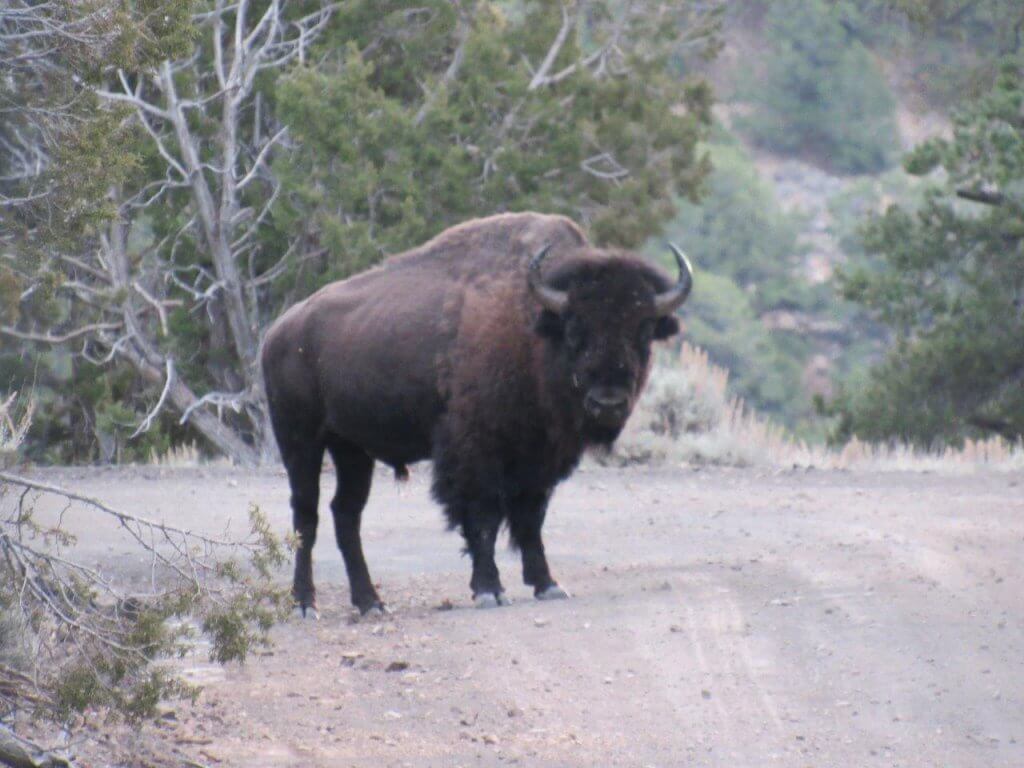
The day before the hunt we came around a bend in the road and a bull stood right in the middle of the track. Good omen or cruel trick? What a way to get the adrenal flowing! Credit RN.
There would be a total of 80 permits awarded across five hunts in the Henry Mountains for 2017. The numbers of these permits vary each year and are based on data, such as aerial surveys assessing the herd’s current population.
Of these 80 tags 39 were to be cow-only harvests and would be open during two slots in December. The first ever archery-only hunter’s choice hunt ran from Oct. 6th—20th and then there would be a second any-legal-weapon hunt from Nov. 18th—30th.
Also, from my statistical analysis, I found that 73 hunters had the same number of bonus points as I did. Of these 73 only 41 applied this year. Fifteen people purchased an additional bonus point, which left 16 hunters uncounted for (death, absence, etc).
Of the 41 applications 15 drew tags somewhere in the state (Antelope Island, Book Cliffs or Henry Mountain). For the hunt slot I applied for, 24 hunters made application and 6 drew a permit.
Utah has a unique way of drawing once-in-a-life time permits, in that half are used for those sportsmen with the largest number of bonus points and the other half are true random.
It felt terrific to be selected after such a long wait. However, given Utah’s system, it was a bit frustrating when I met a sportsman on this hunt (a self-proclaimed “redneck from Tremonton”) who drew after only four years of applying.
****
For me, hunting is not a symphony, not a painting, not to be defined. It is a long,
fascinating road leading to moments never to be forgotten. –Frances Hamerstrom
My interest with the Henry Mountain bison was probably sparked by stories I heard from my Uncle Albert Henry Peterson who had a successful hunt in the 1960s with his friend Jim (who had the tag).
However my “love affair” with the Henry Mountains started in 1992 when I accompanied Steve Smith on his bison hunt there where he killed a young bull.
In subsequent years of 1994, I was with my sister Nadean when she killed her cow bison, in 1998 when brothers Kyle and Bryce Egbert bagged their cows, and then again in 2002 when Wade Carter took his cow with a muzzleloader.
All together I spent 13 days either scouting for or hunting these five successful bison harvests from the Henry Mountains. During this pursuit the number 13, considered unlucky by many, became my “lucky 13” and seemed to crop up in diverse places, at sundry times and weave a common thread to the outcome of my hunt.
In 2009, I made a trip to hike Mt. Ellen’s 11,506 foot peak with Mark Rogniske. I was filled with awe at those incredible, magic sunsets over the water pocket fold of Capital Reef that can’t be replicated anywhere else in the world!
****
As you hunt, you bond with the animals. You start to match heartbeats, and when you do that respect for them and for the land comes naturally. When you hunt buffalo, you know that the herd is not just one big group; it is a collection of families. Sometimes they’re all together and sometimes they separate… –Wildlife biologist Richard Sherman, Where the Heart Is
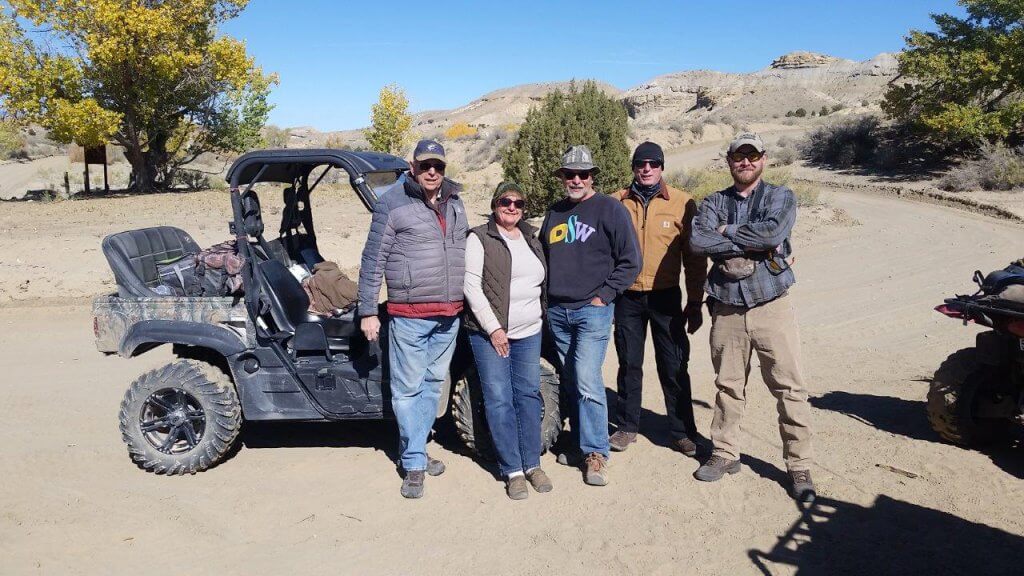
The pit crew: Chad, Jill, Don, Steve W, Mark P. Credit RN.
In May 2017, when I learned of my successful draw my trophy journey began. In the following months I gathered both harvest and aerial data from the division of wildlife resources, and had phone conversations with the state’s wildlife biologist.
I collected maps from the Bureau of Land Management who administers the mountain range, and most importantly, planned and carried out three scouting trips to the Henry Mountains to re-acquaint myself with the roads and terrain.
During these 13 days of scouting in this year alone I saw more than 250 bison in herds from five to more than 70 animals.
The most important and meaningful thing I did during this time was to assemble my “bull pit crew,” This crew consisted of 13 valued members who at some point during my three scouting trips or actual hunt would share the trophy journey on the Henrys with me.
I also met other hunters including Greg Solberg from Grand Junction, Richard Ballard from Logan and two tourists Peter and Michael from Germany at “sunset point” who had hired a guide to take them to the “most remote place in Utah.”
With much help from George Richardson we upgraded my Ruger .270. We floated the barrel, changed from a Weaver 4x to a Leopold 3×9 variable scope, loaded up plenty of 150 grain Nosler Partition bullets, and sighted in my rifle. It was the same gun my father had saved for so he could buy it for me when I was a teenager.
Chad & Mark Peterson also helped with the ballistic and gun patterning. Most of these crew members I was able to treat to the world famous Bessie Stewart’s Pinto Bean Pie at the Sunglow Café in Bicknell, UT.
****
The true hunter counts his achievements in proportion to the effort involved and the fairness of the sport. –Saxton Pope
At last the months of planning, dreaming, and anticipation were over and it was time for the hunt.
On Thursday Nov 2, we loaded up firewood (that Jeff Carver provided), and then Brad Allen, Steve Allred and I headed to our prearranged spot at McMillan Springs campground.
We set up the wall tent that the Bailey’s furnished and then spent the next day and half scouting for the elusive bison.
The day before the hunt we came around a bend in the road and a mature bull stood right in the middle of the track. What a way to get the adrenal flowing! Never before had this happened to me! Was it a good omen or a cruel trick?
On the Friday night before the opener we located five bulls and watched them ‘til sunset.
It takes a great effort to get to the Henry Mountains. As my crew continued to arrive late Friday I was very pleased that three of my nephews were able to be with me for the hunt. Brandon had flown in from Missouri, Todd and Mark from Washington and Cedar City respectively. Also Larry Mickelsen from Soda Springs ID and George Richardson from Manti, both life-long friends of mine.
Under the huge, full moon my bull pit crew and I put together a plot to find the bulls the next morning. How could anyone sleep that night?
****
When it comes to the cold, buffalo have a lot of anatomical tricks up their sleeves. Proportional to body size, the buffalo’s trachea is larger than that of any other large land mammal; when it takes a breath of cold air, the air is pre-warmed inside the trachea before it moves down the animal’s lungs. This way, ambient air temperatures have a diminished effect on the animal’s core body temperature, which is 101.6 degrees Fahrenheit. A buffalo’s coat of hair is another handy adaptation. The thick, shaggy coat is so well insulated that snow can settle on its back without melting. The hair above it’s eyes is so short that it looks like someone buzzed it with a electric clipper. This shortness prevents freeing water from accumulating against sensitive eye tissues. Domestic cattle have longer hair around their eyeballs and are commonly blinded by gobs of ice. – Steven Rinella, American Buffalo
That night as the wind blew and the hours slowly passed, I thought about the bull that might be experiencing his final night on the mountain, after what I hoped was a long and good life having fulfilled the measure of its creation.
If I had the chance for a harvest tomorrow, I wanted my bull to be admired and yet respected by my rifle and me. I wanted my shot(s) to be swift and clean and I reviewed the unique anatomy of the bison to make sure this would happen.
As I nervously shivered in my warm sleeping bag, I thought about my father. In the morning I planned to carry with me the two most cherished possessions he left me: the .270 Ruger rifle and the hand-made knife he gave me at high school graduation. I would also be wearing the buckskin shirt his mother, my Grandmother Nielson, hand-made in her 90th year.
When I awoke in the morning my nephews would be wearing their buckskins my sister Sherrie, their mother, had hand-made for them. We were all carrying on a treasured legacy.
Hunting is so much more than the high points of any one sense. It uses all five senses – and all the knowledge I have accumulated up to that time. – Frances Hamerstrom
Finally morning came! Arising at 5:00 a.m. and after a quick breakfast we all hustled down to the Head of Bullfrog drainage where we had last seen the five bulls.
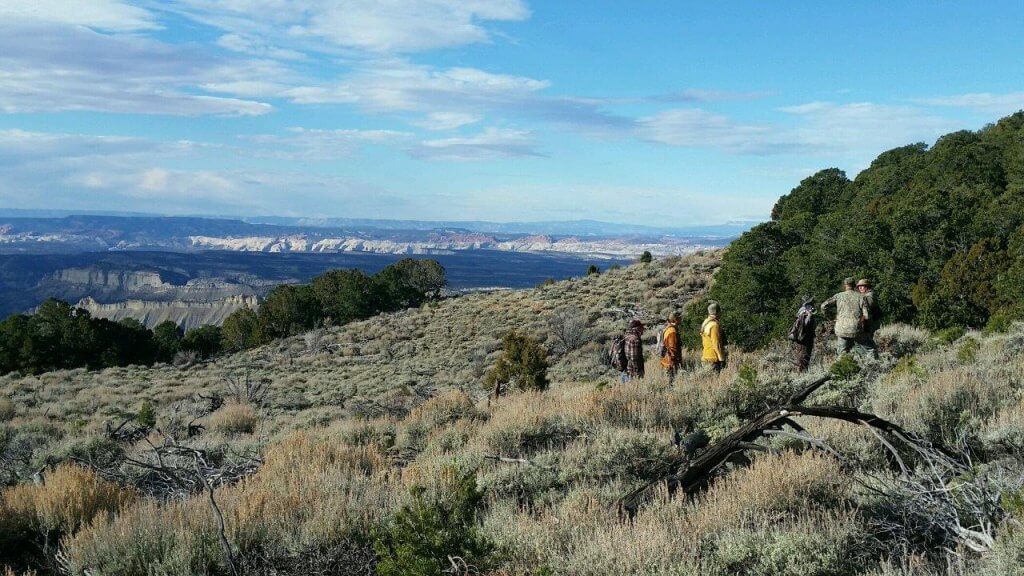
We all hustled down to the Head of Bullfrog drainage where we had last seen the five bulls. Credit RN.
The full moon was still incredibly bright and lit up the desert country to the west. We were in our spots before any other hunters arrived, which was our main objective for heading out so early.
As the sunrise crept over the mountains to the east and the morning stars slowly faded, the coolness of the morning was biting. Brad, George and I were on the same knoll that we had left the night before while watching the five bachelor bulls.
Steve had stationed the other members of the bull pit crew at strategic overlooks to watch and wait, perhaps impatiently.
About 9:00 a.m. the first sighting of four bison appeared. George and I made a plan to try and work up the draw that they seemed to be coming down. Brad was to stay with the spotting scope and provide any information about their movements that he could.
After skirting up the ravine, I saw animal legs through the juniper trees. George and I tried to assess where they might be going and how we could intercept them. We worked up a ridge and came to an opening just moments before four mature bulls walked into full view—no more than 80 yards away!
They were not moving extremely fast, but I believe they knew we were there and were headed for the junipers on the far side. George was still in the trees some distance away, so I knew I had to make the decision myself. I picked the lead bull that gave me a good broadside shot.
At the roar of my Ruger all of the animals became confused.
George called “Which bull?” I returned “The first one.”
The bull that I had just shot stopped but was still standing.
The smallest bull was now right in the way for a good second shot. I waited for what seemed like an eternity for the animals to reshuffle.
Finally I had another chance to place the fatal bullet. After the report of my rifle the bull went towards the junipers and laid down. The other bulls, which were merely a distraction to my focus at this point, moved off.
There would be no long tracking today, only the wait for the bull to go gently into the light of peace.
I named the now lifeless bull “Lucifer,” not in the traditional biblical sense for being bad or evil, but because he was the bright light along the journey’s road. The Venus Star to my life-long love affair.
Lucifer: Latin word meaning “the morning star” or as an adjective “light bringing.”
****
“Killing a large animal inevitably gives me a sense of sorrow. I know it will hit me before it does. it hits as I run my fingers through the tangled mane of the buffalo’s neck. The animal feels so solid, so substantive. I feel compelled to question what I’ve done, to compare the merits of its life with the merits of my own. It’s not so much a feeling of guilt. There’s no moment when I want the buffalo to stand back up and walk away, no moment when I wish the bullet would retreat back into the barrel. It’s more complicated than guilt. Seeing the dead buffalo, I feel an amalgamation of many things; thankfulness for the meat, an appreciation for the animal’s beauty, a regard for the history of its species, and, yes, a touch of guilt. Any one of those feelings would be a passing sensation, but together they make me feel emotionally swollen. The swelling is tender, a little bit painful. This is the curse of the human predator, I think.” – Steven Rinella, American Buffalo
Now the work began. The bull pit crew, who had all found their way to the meadow, was swift to action and worked with great efficiency.
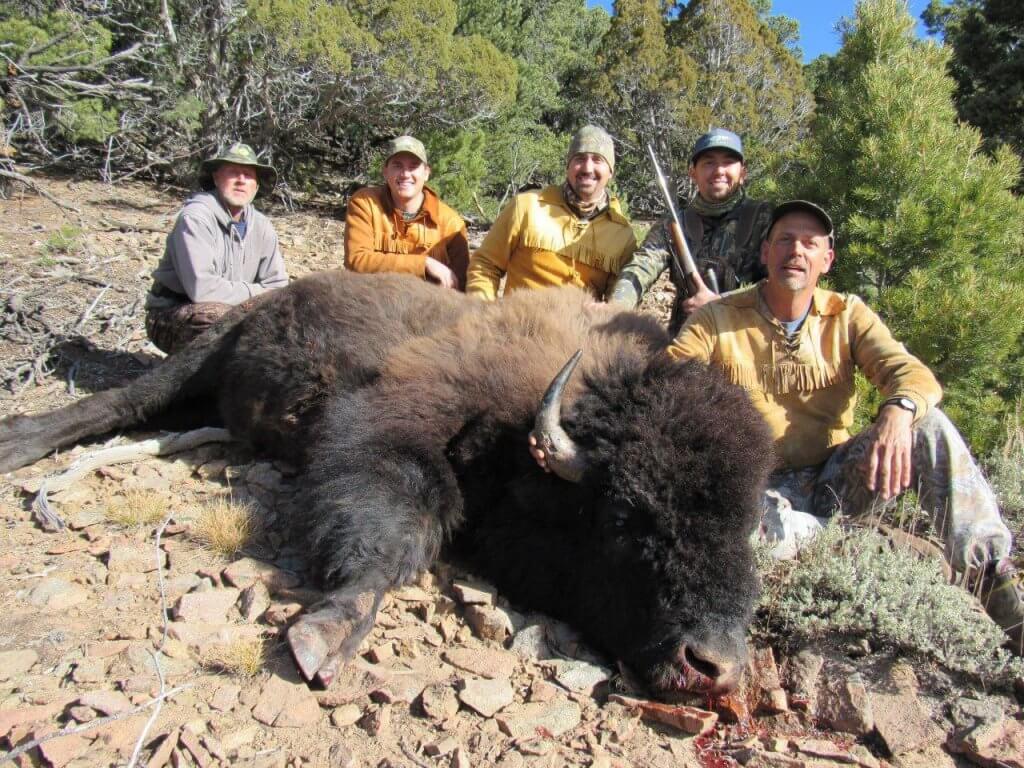
Brad A, Mark A, Brandon A, Todd A and Russell celebrate the trophy seven-year-old bull shot Nov 4, 2017. They wear buckskin shirts made by family members. Credit RN.
But first there was a moment to pay honor and tribute to the mighty seven-year-old bull. It was a beautiful animal with 17” long horns (and a circumference of 13”). We took pictures and relived the chase and then got to work.
It took more than four hours to butcher, skin and cut into multiple pieces. Then Brad A, Mark A, Brandon A, Todd A, and Russell haul them 300-400 yards to my pickup.

George R, Steve A and Russell. I named the now lifeless bull “Lucifer” because he was the bright light along the journey’s road. Credit RN.
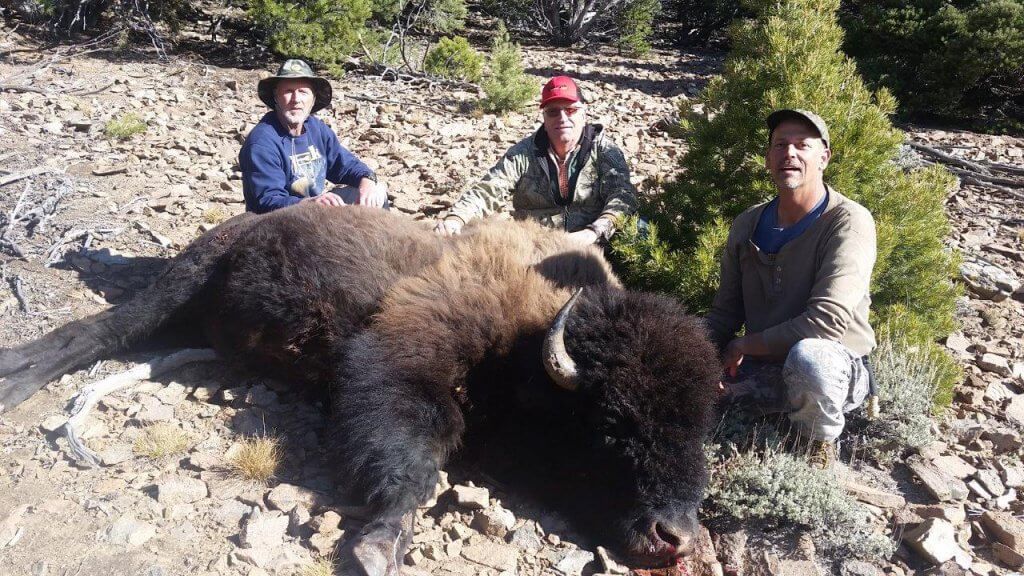
Brad A, Larry M and Russell. We took pictures and relived the chase. Credit RN.
We left no parts of the beautiful specimen behind (this was another best-case scenario hope of mine).
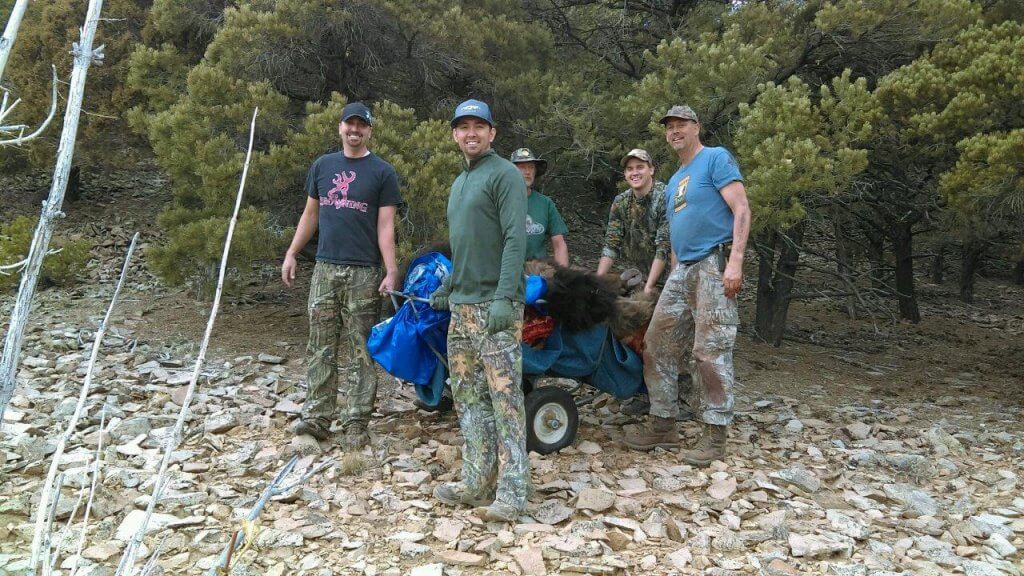
It took more than four hours to butcher, skin and cut into multiple pieces. Then Brad A, Mark A, Brandon A, Todd A and Russell haul the pieces to my pickup. Credit RN.
I was also required by the division of wildlife resources to take blood and tooth samples so that they could age the animal and test for diseases like brucellosis. This data would be helpful in managing the herd in future years.
When we got back to camp, we learned the brothers from Tremonton had killed one of the five bachelors from my group earlier in the morning in the drainage above us. We also met up with Phillip Johnson, the son of Evan Johnson (Grandma Nielson’s brother) from Mt. Pleasant who also had a tag. He had not had any luck yet despite having 19 crewmembers to assist.
We finished the work of securing the animal for transporting while at our camp spot and Brad, Larry and George took him to Manti and Spring City for cooling, hanging and cutting up.
The rest of us stayed the night as Steve Allred the master of comedy entertained us. We broke camp the next day after a heartfelt expression of gratitude by Steve, now the master of sincerity, who said he’s now too old to not express thankfulness…
My 13 reasons of gratitude could really be many more! First and most important I am thankful for those members of my support crew whom I could not have accomplished the hunt without. This crew also includes many family and friends supporting me from distant places like Newfoundland Canada, San Diego California, and Monument Colorado. For Don Simmons the oldest, and perhaps the strongest and my most faithful supporter at 91 years of age.
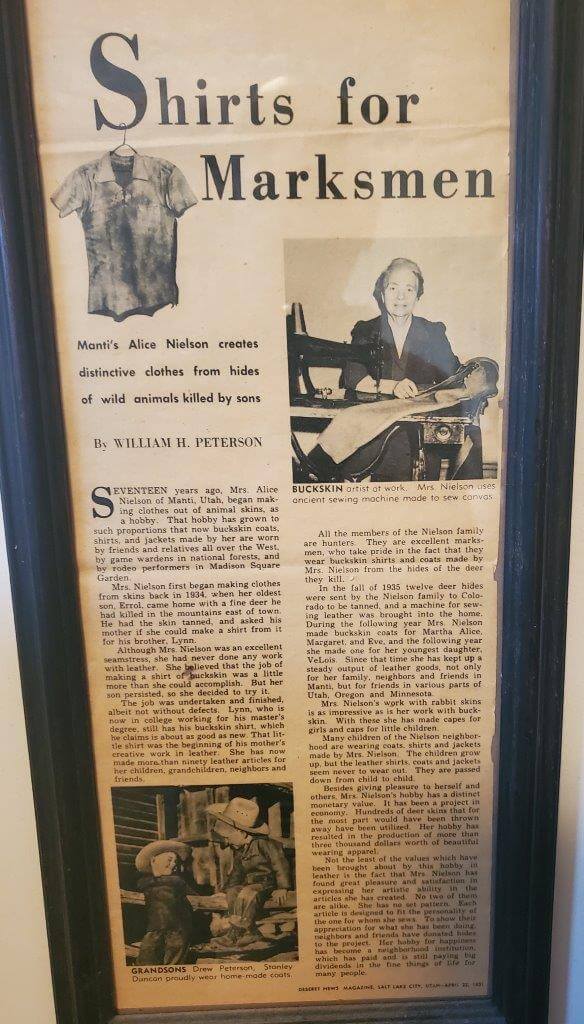
My Grandmother Nielson made my buckskin shirt when she was 90 years old on an old Treadle Sewing Machine—the final one she made, as she passed away later that year. Credit RN.
My Grandmother Nielson made my buckskin—Mule Deer—shirt when she was 90 years old on an old Treadle Sewing Machine. It was the final one she made as she passed away later that year. She made hundreds of buckskin shirts, jackets and coats, beside baby booties, etc, through the years for family and friends (see newspaper article). My sister took patterns from some of her work and made shirts for her sons as kind of a coming-of-age gesture (had to kill two deer to have enough leather to make a shirt). Additionally, we were taught and trained to use as much of the harvested animal as possible which included the hide.
I also express gratitude to those who helped bring the bison back from the brink of extinction. What an amazing, wonderful, interesting, majestic animal! LONG MAY THEY ROAM!!
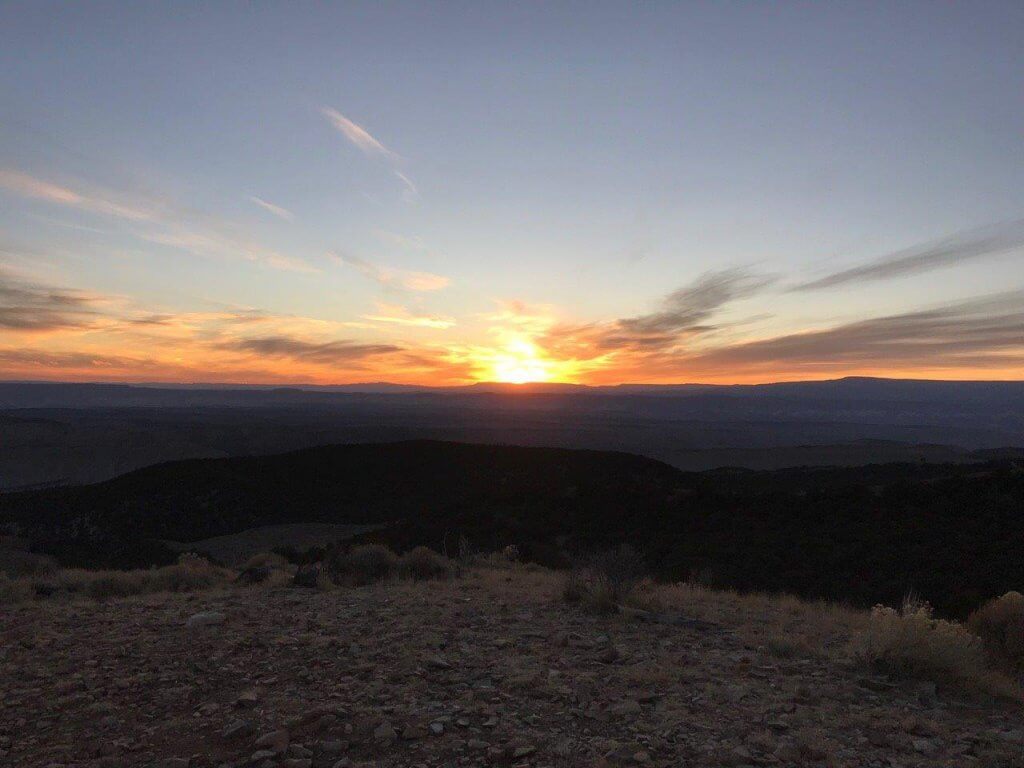
The hunters enjoyed one last, beautiful sunset from their campground. Credit RN.
Blog 44 written by Guest Editor J. Russell Nielson, of Salt Lake City and hometown Manti, Utah, “Lucifer and Lucky Thirteen” Nov 2017.
Thanks Russell, a magnificent tale, well told! Your quotes from other hunters are so effective and put into words the respectful and even awed response with which many hunters approach their game. So glad you included them! It’s fun, too, that you gave us your “lucky 13” as it applies to your trophy buffalo—circumference of base of each horn nearly 13 inches, 13 members of your “bull pit crew,” the 13 days you spent scouting with earlier hunters in the Henry Mountains on five previous trips. And 13 showed up again with 13 resident permits granted in your special year 2017 and 13 important Henrys and Henries in your life. We are delighted to present your authentic Buffalo Hunting story in honor of National Bison Day, Nov 6, 2021, First Saturday in November! Let’s all celebrate the day by telling—and enjoying—Buffalo stories! -Best Wishes, Francie M. Berg, Editor www.BuffaloTalesansTrails.com
___________
NEXT: Buffalo Sounds and Vocalizations
__________

